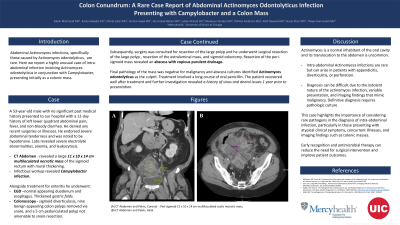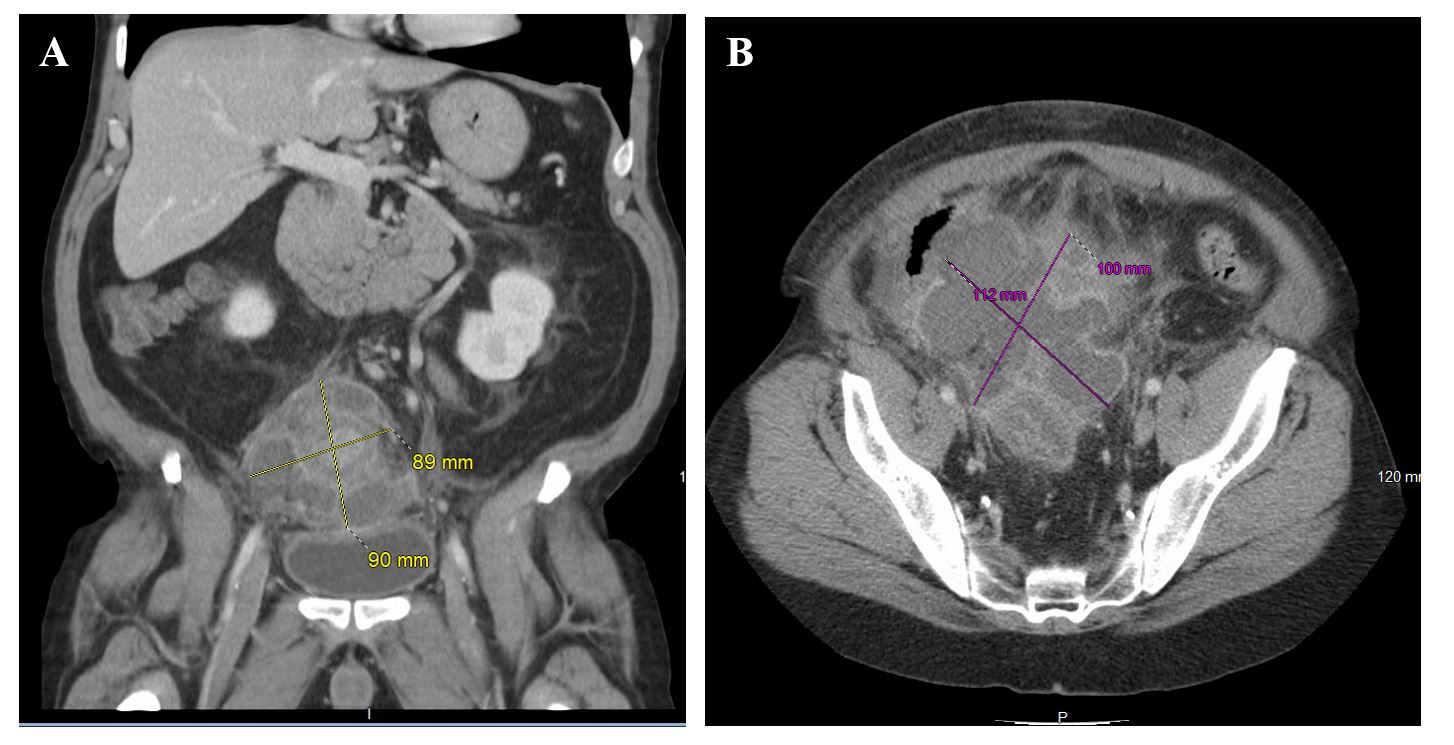Tuesday Poster Session
Category: Colon
P3710 - Colon Conundrum: A Rare Case Report of Abdominal Actinomyces odontolyticus Infection Presenting With Campylobacter and a Colon Mass
Tuesday, October 29, 2024
10:30 AM - 4:00 PM ET
Location: Exhibit Hall E

Has Audio
- SM
Sabah Mahmood, MD
Mercy Health
Rockford, IL
Presenting Author(s)
Sabah Mahmood, MD1, Rootul Kakadia, DO1, Ahmet Sakiri, MD1, Ammar Aqeel, MD2, Abu Fahad Abbasi, MD1, Sultan Ahmed, DO1, Mudassar Sandozi, DO1, William Andersen, BSc3, Altaf Dawood, MD, MBBS1, Naser Khan, MD1, Thayer Hamoudah, MD1
1Mercy Health, Rockford, IL; 2Mercy Health, Loves Park, IL; 3University of Illinois College of Medicine, Loves Park, IL
Introduction: Abdominal Actinomyces infections, specifically those caused by Actinomyces odontolyticus, are rare. Actinomyces is a normal inhabitant of the oral cavity and its translocation to the abdomen is uncommon. Concurrent infections with Campylobacter can complicate the clinical picture and pose diagnostic challenges delaying treatment. Here we report a highly unusual case of intra-abdominal infection involving Actinomyces odontolyticus in conjunction with Campylobacter, presenting initially as a colonic mass.
Case Description/Methods: A 53-year-old male with no significant past medical history presented to our hospital with a 12-day history of left lower quadrant abdominal pain, fever, and non-bloody diarrhea. On exam, the patient was hypotensive and had abdominal tenderness. He denied any recent surgeries or illnesses. His labs noted severe anemia, leukocytosis, and electrolyte derangements. Abdominal CT revealed a large 11 x 10 x 14 cm multiloculated necrotic mass of the sigmoid rectum with mural thickening suspicious for malignancy. Colonoscopy showed thick gastric folds, sigmoid diverticulosis, and multiple benign colon polyps but no evidence of dysplasia. Infectious workup revealed Campylobacter infection. The patient then underwent surgical resection of the extraluminal mass revealing an abscess with copious purulent drainage along with a sigmoid colectomy. The final sigmoid pathology was negative for malignancy but microbiologic cultures of the abscess identified Actinomyces odontolyticus as the culprit. Treatment involved a long course of oral penicillin. The patient recovered well after treatment and further investigation revealed a history of sinus and dental issues 1 year prior to presentation.
Discussion: Actinomyces odontolyticus infections can result from disruption of the mucosal barrier. Intra-abdominal infections are rare but can arise in patients with appendicitis, diverticulitis, or perforation. Diagnosis can be difficult due to the indolent nature of the actinomyces infection, variable presentation, and imaging findings that mimic malignancy. Definitive diagnosis requires pathologic culture. This case highlights the importance of considering rare pathogens in the diagnosis of intra-abdominal infection, particularly in those presenting with atypical clinical symptoms, concurrent illnesses, and imaging findings such as colonic masses. Early recognition and antimicrobial therapy can reduce the need for surgical intervention and improve patient outcomes.

Disclosures:
Sabah Mahmood, MD1, Rootul Kakadia, DO1, Ahmet Sakiri, MD1, Ammar Aqeel, MD2, Abu Fahad Abbasi, MD1, Sultan Ahmed, DO1, Mudassar Sandozi, DO1, William Andersen, BSc3, Altaf Dawood, MD, MBBS1, Naser Khan, MD1, Thayer Hamoudah, MD1. P3710 - Colon Conundrum: A Rare Case Report of Abdominal <i>Actinomyces odontolyticus</i> Infection Presenting With <i>Campylobacter</i> and a Colon Mass, ACG 2024 Annual Scientific Meeting Abstracts. Philadelphia, PA: American College of Gastroenterology.
1Mercy Health, Rockford, IL; 2Mercy Health, Loves Park, IL; 3University of Illinois College of Medicine, Loves Park, IL
Introduction: Abdominal Actinomyces infections, specifically those caused by Actinomyces odontolyticus, are rare. Actinomyces is a normal inhabitant of the oral cavity and its translocation to the abdomen is uncommon. Concurrent infections with Campylobacter can complicate the clinical picture and pose diagnostic challenges delaying treatment. Here we report a highly unusual case of intra-abdominal infection involving Actinomyces odontolyticus in conjunction with Campylobacter, presenting initially as a colonic mass.
Case Description/Methods: A 53-year-old male with no significant past medical history presented to our hospital with a 12-day history of left lower quadrant abdominal pain, fever, and non-bloody diarrhea. On exam, the patient was hypotensive and had abdominal tenderness. He denied any recent surgeries or illnesses. His labs noted severe anemia, leukocytosis, and electrolyte derangements. Abdominal CT revealed a large 11 x 10 x 14 cm multiloculated necrotic mass of the sigmoid rectum with mural thickening suspicious for malignancy. Colonoscopy showed thick gastric folds, sigmoid diverticulosis, and multiple benign colon polyps but no evidence of dysplasia. Infectious workup revealed Campylobacter infection. The patient then underwent surgical resection of the extraluminal mass revealing an abscess with copious purulent drainage along with a sigmoid colectomy. The final sigmoid pathology was negative for malignancy but microbiologic cultures of the abscess identified Actinomyces odontolyticus as the culprit. Treatment involved a long course of oral penicillin. The patient recovered well after treatment and further investigation revealed a history of sinus and dental issues 1 year prior to presentation.
Discussion: Actinomyces odontolyticus infections can result from disruption of the mucosal barrier. Intra-abdominal infections are rare but can arise in patients with appendicitis, diverticulitis, or perforation. Diagnosis can be difficult due to the indolent nature of the actinomyces infection, variable presentation, and imaging findings that mimic malignancy. Definitive diagnosis requires pathologic culture. This case highlights the importance of considering rare pathogens in the diagnosis of intra-abdominal infection, particularly in those presenting with atypical clinical symptoms, concurrent illnesses, and imaging findings such as colonic masses. Early recognition and antimicrobial therapy can reduce the need for surgical intervention and improve patient outcomes.

Figure: Images - CT Abdomen and Pelvis, Coronal (A) and Axial (B) views -Peri-sigmoid 11 x 10 x 14 cm multiloculated cystic necrotic mass.
Disclosures:
Sabah Mahmood indicated no relevant financial relationships.
Rootul Kakadia indicated no relevant financial relationships.
Ahmet Sakiri indicated no relevant financial relationships.
Ammar Aqeel indicated no relevant financial relationships.
Abu Fahad Abbasi indicated no relevant financial relationships.
Sultan Ahmed indicated no relevant financial relationships.
Mudassar Sandozi indicated no relevant financial relationships.
William Andersen indicated no relevant financial relationships.
Altaf Dawood indicated no relevant financial relationships.
Naser Khan indicated no relevant financial relationships.
Thayer Hamoudah indicated no relevant financial relationships.
Sabah Mahmood, MD1, Rootul Kakadia, DO1, Ahmet Sakiri, MD1, Ammar Aqeel, MD2, Abu Fahad Abbasi, MD1, Sultan Ahmed, DO1, Mudassar Sandozi, DO1, William Andersen, BSc3, Altaf Dawood, MD, MBBS1, Naser Khan, MD1, Thayer Hamoudah, MD1. P3710 - Colon Conundrum: A Rare Case Report of Abdominal <i>Actinomyces odontolyticus</i> Infection Presenting With <i>Campylobacter</i> and a Colon Mass, ACG 2024 Annual Scientific Meeting Abstracts. Philadelphia, PA: American College of Gastroenterology.
